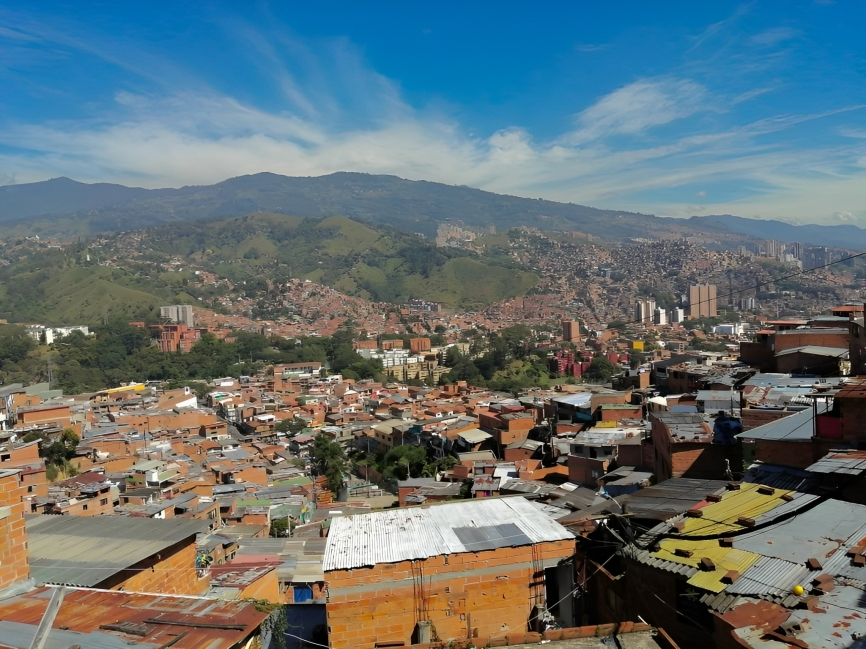La Comuna 13: From Nothing to Something
As I ascended the escalators, the vibrant street art and upbeat music greeted me. The Comuna 13 of Medellín, once notorious for violence, was now standing before me, thriving with community spirit and creativity.
After arriving via Metro at Estación San Javier with my cousins, and taking a bus ride that felt more like an elevator because of how steep some streets were. We stood at the foot of the electric stairs of the Comuna 13, a neighborhood once considered one of the most dangerous places in Latin America, that is now a center of cultural development and opportunities.
The Comuna 13, San Javier, is one of the 16 comunas of Medellín. Located to the southeast of the city, the comuna has 171,646 inhabitants, made up of 22 neighborhoods, mostly of poor households.
It was originally settled by low-income families in the 1950s and grew rapidly over the next few decades. However, in the 1980s and 1990s, the area became known for its high rates of violence and gang activity, as drug cartels and paramilitary groups fought for control of the city. Since then, the locals have implemented different cultural programs to improve the economy, safety, and overall condition of the place.
Juan Diego Mosquera, our tour guide, welcomed us with open arms to his home. He was born and raised in San Javier and is proud of where he comes from. But Mosquera is also a survivor. Before starting the tour, he shared the history of violence in the Comuna 13.
In 2002, with the goal of dismantling illegal armed groups and restoring security in the city, the government carried out “Operación Orión”. The operation involved over 1,000 soldiers, police officers, and helicopters, and resulted in the deaths of many civilians and the displacement of thousands of people. The operation was highly controversial, with allegations of human rights violations and extrajudicial killings by the security forces. While some argue that the operation helped reduce violence in the city, others argue that it created more problems in the long run.
“I will never forget that couple of days, seeing my uncle die, never seeing some of my friends again. It was tragic, it should’ve never been carried out that way. Yes, it helped to regain some of the safety we had before, but many innocent lives where took and we never got an answer for this,” Mosquera said.
Since Operación Orion, locals have worked to improve the safety and economy of their home by implementing a vast variety of businesses, including their most popular tourist attraction, the Graffitour, which we decided to take. This tour consists of a walk through the comuna with the purpose of admiring its street art, and the thousands of graffities in their walls.
As we walked through the narrow streets, the tour guide described the symbolic meaning behind many of the graffiti images. Some of them tell the stories of families that lived in the comuna, some criticize the government, and some remember the Operación Orion. In addition to the graffitis, the tour welcomed us with dancing, rap music, and many other activities popular at the comuna. Locals where filled with happiness, and were always ready to help out.
“The happiness of the locals is definitely contagious. I feel welcomed, and safe also. I have lived in Medellín all my life, and never dared to even get close to San Javier, but now I am here. A change has definitely happened here,” Flor Yepes, graffitour tourist, said.
But the graffitour is not the only thing to do at the Comuna 13. After finishing our tour, we decided to take part in another activity.
This time, we went to a house designed specifically for music production. The comuna is known for its musical talent, specifically in rap music. The house had many studios, and as it was explained to us, one of its main purposes is to keep teens and kids away from the streets with the help of music.
“Music helped me at my lowest point. I was drug dealing, and consuming too. My life was filled with violence, with hate. Rap helped me get away from all this. Its a form of poetry, and I opened this studio house with the hope of helping kids that are lost like I was to choose a better path,” Freddy Silgado, owner of the studio house, said.
We left San Javier and the Comuna 13 after 5 hours, took the metro back home and arrived with no problems. Locals always looked out for us, and greeted us at every place we arrived with open arms and a big smile in their faces. We felt safe, even safer than in other places in Medellín. And most important, we felt welcomed.
“La trece is my home, it will always be. People should be proud of where they come from, and make an effort to contribute to their communities. San Javier has a lot to offer, and we’ve come a long way and will continue to progress,”
Mosquera said.




